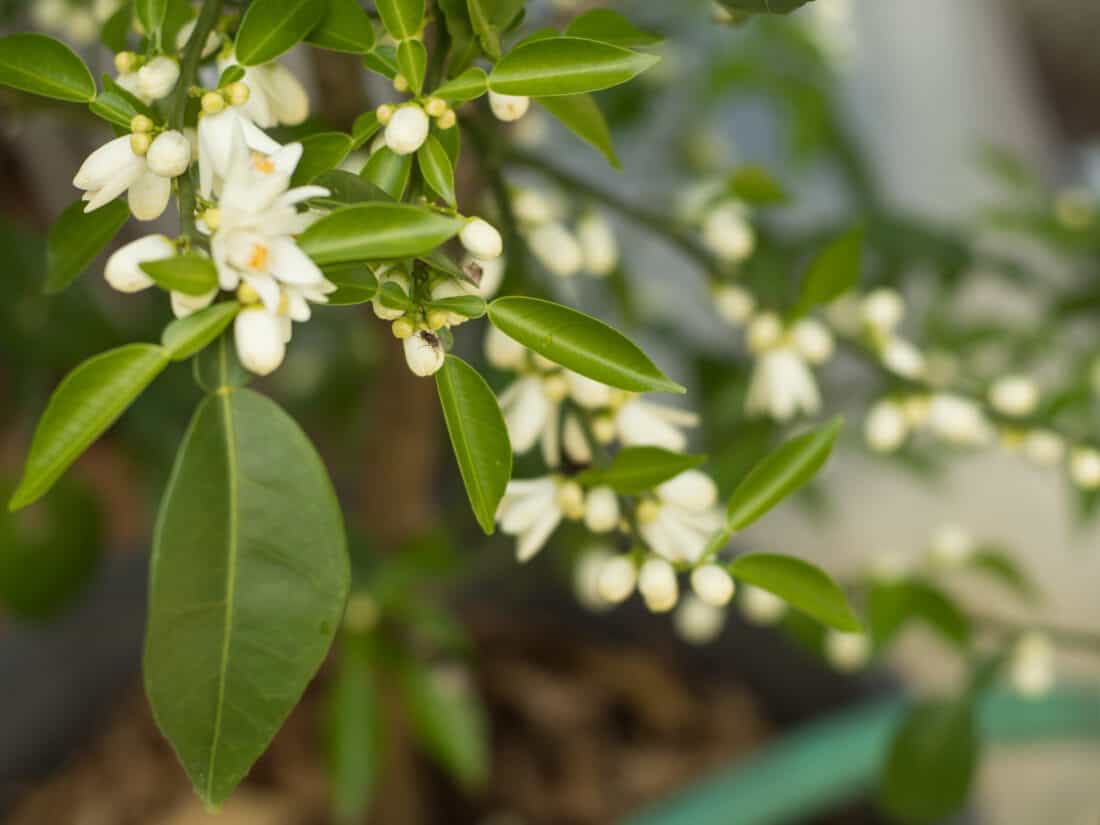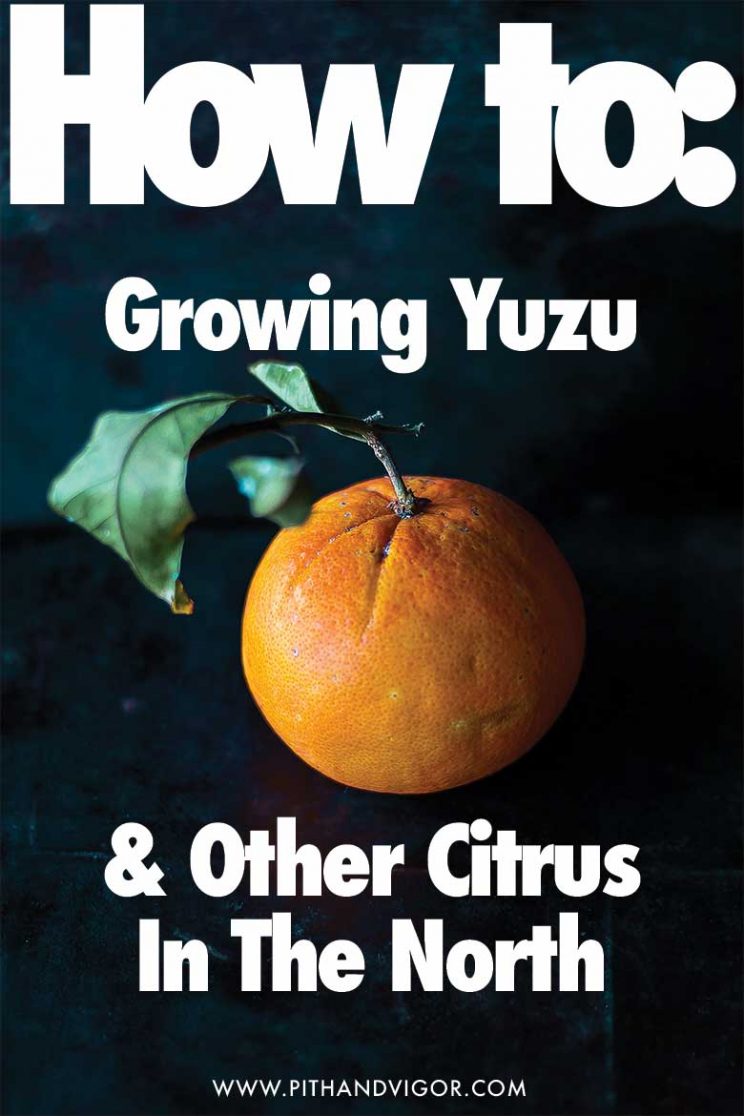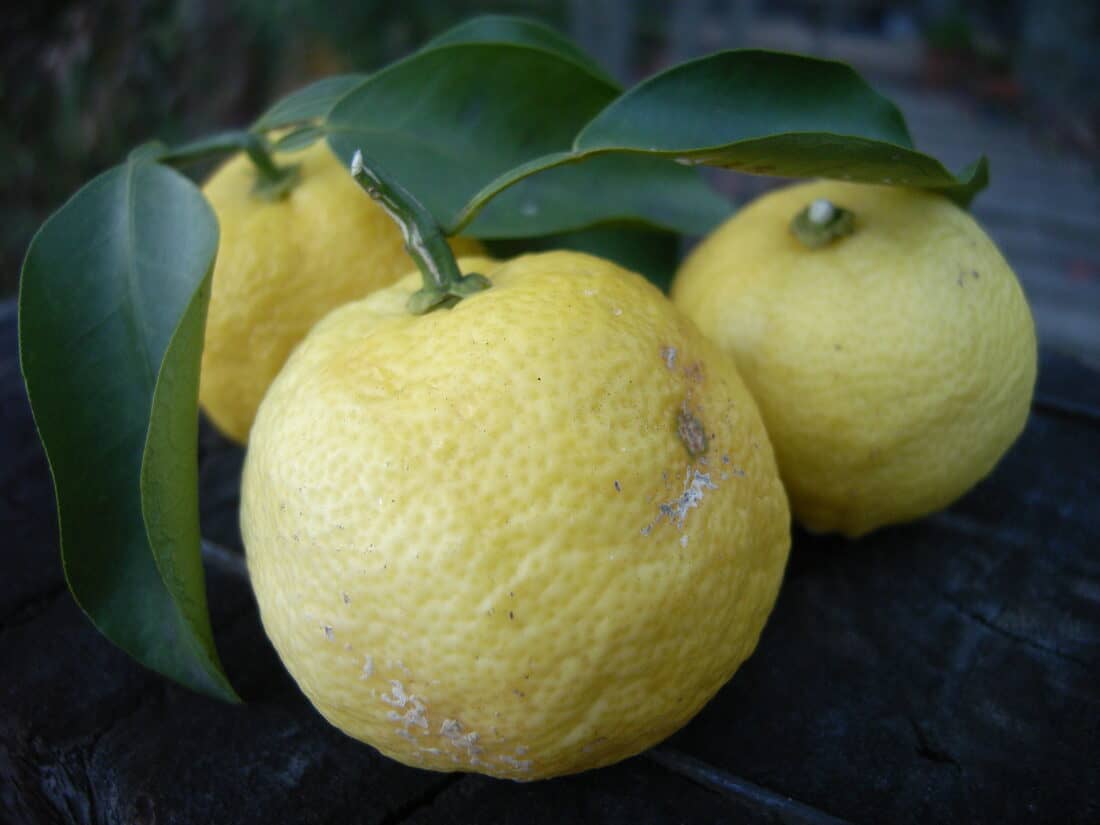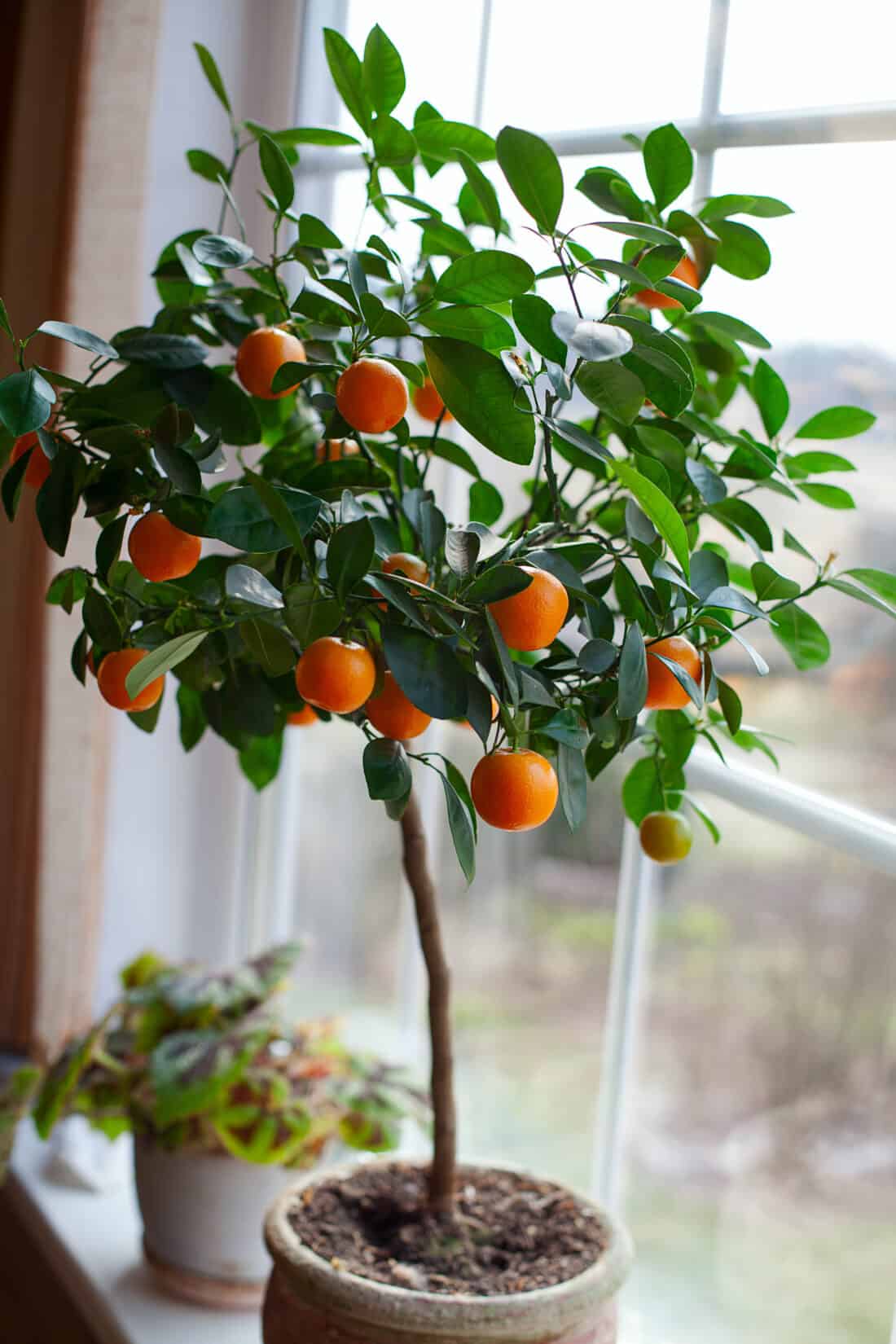Perhaps this post should have a different title, like “How to Have an Orangerie Even if You Aren’t a Member of a Royal Family”. Or “Juicy Fruits – The Taste is Gonna Move Ya”. Growing yuzu and other citrus fruits indoors in something that is both entirely worth it and entirely possible for gardeners anywhere (even in the north). Matt Mattus shares with us his advice for how to grow yuzu (latin: citrus junos) indoors. As a gardener in Worcester, MA, Matt grows a variety of citrus (including yuzu) indoors and shows us that growing yuzu and yuzu tree care is easier than you might think. Turning over to Matt…
How to Grow Yuzu (and other Citrus trees) Indoors

Yuzu goes by many names. Besides yuzu, you might also see plants labeled as Japanese citron, ot hana yuzu. Yuzu is used in both cooking and bathing.
A yuzu bath is popular in east asia around the winter solstice (It is a time of celebration called Toji). It is meant to bring good luck and good health as well as to ward off colds and encourage relaxation. Make a bath with yuzu juice and yuzu essential oils infused into hot bath water.
Few indoor plants can combine so much value within a single pot as citrus trees. There are the obvious benefits – a lovely, small tree, an annual flush of fragrant small white flowers. Later, they are often bedecked with colorful fruit, which, to be honest, is so pretty that one feels a little guilty picking even a single orb that took half a year to ripen. Plus there are the health benefits ((lots of vitamin c!). Yuzu lemons are popular in Japanese cuisine, where the juice, peel, and seeds are used as flavorings for all sorts of vinegar, seasonings, sauces, and marmalades.
But don’t be too enthralled with the citrus tree’s beauty. You will be denying yourself one of the greatest pleasures for the palate and soul because freshly picked citrus tastes nothing like supermarket fruit. If you don’t believe me, just scratch the rind of any containerized citrus while it is still on the tree and inhale the oil. The smell begins evaporating just hours after the fruit is picked, leaving most people with a completely different citrus experience. Fresh yuzu and other citrus are like tomatoes – the best way to eat the ripe fruit is fresh and straight from the plant.

Fruit so good you can eat them whole
I learned this once while visiting a farm in California. The proprietor took me over to an old, gnarly kumquat tree with its branches hanging heavy with brilliant orange fruit. “Go on, eat it but eat it whole,” he said.
“Eat it whole?” I thought. “Yuck, but…OK.”
Do you know that scene in the animated Disney film “Ratatouille” when the rat first experienced French cuisine? Yeah. It was kind of like that. I swear that I saw colored, swirling lights in my eyes. My mouth exploded first, and then my mind.
The sugars and oils in the skin of freshly picked produce make all the difference in the world when it comes to their flavor profile. It is no surprise that the aromatic zest of many citrus varieties is a key ingredient in recipes. Kumquats are like the flavor of tangerine Life Savers with the flavor scent of orange blossoms, lemon blossoms and cotton candy. Really – heaven tastes like this. Perfume-y, tangy, sour and sweet. Boom.
Needless to say, I was very disappointed when I returned home to snowy New England, and I picked up a pack of kumquats at the store. I popped one in my mouth, and the taste was bitter and dry. I knew then that I just had to grow some myself.
Yuzu and Other Citrus Tree Growing Care
In my first winter of raising a few small young trees indoors and in the greenhouse, I discovered that by the middle of January, I had so much fruit that I could not use it all.
Before you start, however, there are a few things you must know. First off – those little sprouted seeds that you found in the grapefruit this morning? Throw them away.
It is a common question: Can you grow yuzu plants and other citrus trees from seed? The answer is no, not really.
Forget any visions of raising your own clementines from a paper towel full of seeds. It’s just not going to happen for many botanical and agricultural reasons. If you want to try raising your own young plants from seed, you may have the best luck with Key limes, but even with those, expect at least an 8-10 year lead time.

Don’t Grow Yuzu and other Citrus From Seed
You will have practically a foolproof harvest if you buy your plants, either from your local nursery, or from a mail order source. Like many fruit trees, citrus is generally enhanced by grafting, especially with named cultivars. If you want to raise a mandarin orange (clementines to most of us), then buy an established grafted plant. The larger it is, the sooner you will have fruit.
The benefits of grafted trees go far beyond the citrus farm, particularly with indoor culture. Varieties are grafted to enhance early blooming and fruiting and, most importantly, a smaller, more reasonably sized tree.
Citrus Trees and Yuzu are Highly Regulated
Finding the perfect citrus plant is not always as easy as one expects it to be. Citrus plants are highly regulated due to a long list of agricultural diseases that can be spread from one farm to the next.
There is a reason why the Department of Agriculture has a check-off box on your flight back from Hawaii. Citrus farming is big business. Don’t let this stop you, however. Regional sources can be found, or mail-order sources can sell inspected plants ready for you to place into a pot.
Good varieties of citrus are rarely inexpensive as the grafting process adds at least an additional year onto the growing cycle on the nursery side. But if you are going to bother with trying to raise your own fruit, the initial investment won’t be regrettable. After five years, you can expect to have a strong, healthy tree full of fruit while the snow flies outside.
Plan on spending $30 or more for a proven indoor variety, one which has been carefully grafted.

Keeping Citrus Indoors
In many ways, keeping citrus indoors is akin to keeping chickens. Invest in good stock and grow them in well-drained soil. Care for them well with food and water, fresh air in the summer, and bright sunshine (full sun!), and in mid-winter, you start reaping the rewards. My two ‘Improved Meyer’ lemon trees provide my kitchen with nearly 150 lemons each winter. That supplies us with at least two lemons a day for drinks and tea, plus a few dozen left over for marmalade.
Although I keep my plants in a cool greenhouse in Massachusetts, before I built it, the citrus was raised in two spare bedrooms, which were kept cooler than the rest of the house.
Really, all that is needed is a sunny window (to maximize hours of direct sunlight) and a room with a temperature shift from day to night, which will help keep the trees fresh and vibrant. Most citrus prefer indoor conditions, as long as your home isn’t too hot and dry. The easiest citrus plants to grow are Kumquats. Citrons, lemons, and limes can be abundant enough that you would not have to buy any fruit for an entire winter.
Grow Citrus trees for the Beautiful fragrant Blooms.
Aside from the somewhat practical reasons for actually having fruit in abundance, don’t dismiss the holistic reward of fragrance. I mean, lemon blossoms? Really.
Speaking of flowers, good pollination is not always a sure thing when your plants do bloom. Set any blooming plants outdoors on a mild day to allow bees to do their job or just hand pollinate with a soft watercolor brush. Small fruit will begin to form after the blossoms shatter and should slowly grow in warm temperatures throughout the late summer.
One of the best things you can do for a homegrown potted citrus tree is to set it outdoors for the summer. The benefits are many, but mostly, it gives you a vacation from watering it (they tend to need a lot of water), and it will help the plant thrive.
Citrus raised in containers prefer soil that is rather low in organic matter. While an online search will uncover dozens of recommended soil mixes containing wood bark and commercial potting soil, I fear that many writers are simply repeating found cultural information, which often isn’t accurate. Commercial growers know that citrus prefers sandy or loamy soil. Container-raised plants will need additional drainage material, as nothing will kill citrus as quickly as soggy roots.
Citrus and Yuzu also prefer to be under-potted, meaning that they prefer smaller pots rather than larger pots. The good news is that a citrus tree can remain in the same pot for ten years or more once they are large enough for a 12 or 14-inch pot. Weight can be a problem. You are more likely to succeed if you use a clay pot. Clay pots are more forgiving when it comes to moisture retention.

How to grow Yuzu Indoors and Citrus Tree Care
Nutrition is perhaps the most perplexing skill to master. Basic multi-purpose formulas will only go so far. All citrus tree plants appreciate a higher dose of nitrogen when they are young, preferably in the spring and summer. Yellow leaves are the most common problem, which can seem problematic to home growers. One of the fastest ways to kill a citrus tree is to over-fertilize in an effort to remedy yellowing leaves. Iron deficiency is the most common diagnosis, and it is easy to remedy with a citrus fertilizer containing chelated zinc or iron. Your basic big box store may not carry such a blend, but it can almost always be found at a hydroponic supply store.
Lastly, don’t be afraid to prune your trees, taking care not to trim below any grafted parts. Citrus can handle rather harsh pruning. But don’t get crazy and try to create a topiary or a perfect form. Citrus grow in spurts of only once or twice a year, so keep your most severe pruning to late winter before flowers form.
By Matt Mattus
Where to Buy Citrus and Yuzu Trees
In the UK – Check this Etsy Seller
In the USA – You can look at Home Depot or Walmart or Etsy (and you might find something). But the best selection I have found online though is at Nature Hills Nursery – a reputable nursery that will make sure your plants aren’t tortured before they arrive (which cannot always be promised by the big box stores).
Other Varieties of Japanese Citrus Fruit to Try Growing:
Ichang Paeda – scientifically known as Citrus ichangensis, is a remarkable citrus species with origins in the Ichang Valley in Hubei, China. This citrus variety stands out for its robust flavor and culinary uses. It’s often used for essential oils. Ichang papeda also plays a role in citrus breeding programs due to its cold hardiness and disease resistance, making it a valuable resource for developing new citrus varieties with enhanced traits.
Ichang Lemon – It is unclear if Ichang lemon is child of Ichang Paeda or it is suspected to possibly be a Yuzu x pomelo cross. It similarly has very juicy fruits, producing up to a half-cup of juice per lemon. Most citrus ripens in late fall and around the winter solstice. The Ichang lemon is, however, among the earliest to fruit (often in September), which can be helpful for Northern gardeners.
For a tougher plant, a Yuzu Ichandrin hardy citrus tree will produce fruit with a lemon-lime flavor but will survive temperatures as low as zero degrees Fahrenheit. This hardy variety is a good choice if you have mild winters and want to leave your tree pot outside.
comments +